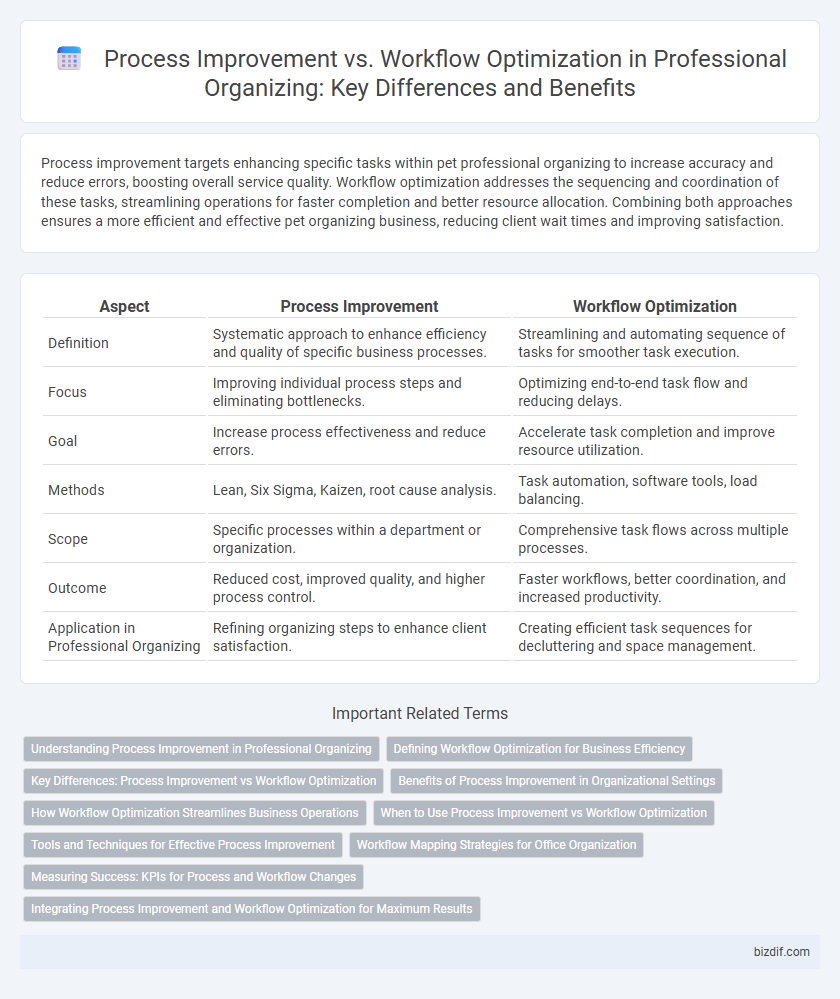Process improvement targets enhancing specific tasks within pet professional organizing to increase accuracy and reduce errors, boosting overall service quality. Workflow optimization addresses the sequencing and coordination of these tasks, streamlining operations for faster completion and better resource allocation. Combining both approaches ensures a more efficient and effective pet organizing business, reducing client wait times and improving satisfaction.
Table of Comparison
| Aspect | Process Improvement | Workflow Optimization |
|---|---|---|
| Definition | Systematic approach to enhance efficiency and quality of specific business processes. | Streamlining and automating sequence of tasks for smoother task execution. |
| Focus | Improving individual process steps and eliminating bottlenecks. | Optimizing end-to-end task flow and reducing delays. |
| Goal | Increase process effectiveness and reduce errors. | Accelerate task completion and improve resource utilization. |
| Methods | Lean, Six Sigma, Kaizen, root cause analysis. | Task automation, software tools, load balancing. |
| Scope | Specific processes within a department or organization. | Comprehensive task flows across multiple processes. |
| Outcome | Reduced cost, improved quality, and higher process control. | Faster workflows, better coordination, and increased productivity. |
| Application in Professional Organizing | Refining organizing steps to enhance client satisfaction. | Creating efficient task sequences for decluttering and space management. |
Understanding Process Improvement in Professional Organizing
Process improvement in professional organizing involves identifying inefficiencies and implementing systematic changes to enhance overall productivity and reduce wasted time. This approach focuses on analyzing each step of the organizing process to streamline tasks, eliminate redundancies, and improve resource allocation. By prioritizing continuous assessment and refinement, professional organizers can deliver more consistent, effective results tailored to clients' specific needs.
Defining Workflow Optimization for Business Efficiency
Workflow optimization focuses on analyzing and refining business processes to eliminate bottlenecks, reduce waste, and enhance task efficiency. It involves streamlining operations using tools like automation software, process mapping, and performance metrics to maximize productivity. Defining workflow optimization in business emphasizes continuous improvement aimed at achieving faster turnaround times and cost-effective project completion.
Key Differences: Process Improvement vs Workflow Optimization
Process improvement targets refining individual tasks within a system to increase efficiency and reduce errors, often through analyzing performance metrics and eliminating bottlenecks. Workflow optimization focuses on streamlining the sequence of interconnected tasks and their handoffs to enhance overall flow and coordination across teams or departments. Key differences lie in scope and approach: process improvement hones specific activities, while workflow optimization emphasizes the integration and timing of those activities for maximum organizational productivity.
Benefits of Process Improvement in Organizational Settings
Process improvement enhances organizational efficiency by identifying and eliminating inefficiencies within existing processes, leading to higher productivity and reduced operational costs. It fosters continuous improvement, enabling teams to adapt swiftly to changing demands and improve overall service quality. Streamlined processes contribute to better resource allocation, increased employee satisfaction, and stronger customer outcomes in professional organizing environments.
How Workflow Optimization Streamlines Business Operations
Workflow optimization systematically refines business processes by eliminating redundancies, automating repetitive tasks, and enhancing task sequencing to increase efficiency. By leveraging tools like process mapping software and automation platforms, workflow optimization reduces operational bottlenecks and accelerates project completion times. This streamlined approach enables businesses to improve resource allocation, boost productivity, and deliver consistent outcomes with minimal errors.
When to Use Process Improvement vs Workflow Optimization
Process improvement targets enhancing specific processes by identifying inefficiencies and implementing changes to boost performance and quality. Workflow optimization is best suited when the focus is on streamlining the overall sequence of tasks and interactions among different processes to increase efficiency and reduce bottlenecks. Use process improvement for detailed problem-solving in individual steps, while workflow optimization is ideal for redesigning end-to-end operations to achieve smoother, faster outcomes in professional organizing.
Tools and Techniques for Effective Process Improvement
Process improvement relies on methodologies like Lean, Six Sigma, and Kaizen to systematically identify inefficiencies and reduce waste, while workflow optimization emphasizes designing or re-engineering processes using digital tools such as process mapping software, automation platforms, and project management apps. Techniques including root cause analysis, value stream mapping, and the use of Key Performance Indicators (KPIs) enable organizations to measure progress and refine procedures effectively. Integrating collaborative tools like Trello or Asana enhances communication and task tracking, ensuring continuous improvement and alignment with business objectives.
Workflow Mapping Strategies for Office Organization
Workflow mapping strategies for office organization enhance process clarity by visually outlining task sequences, roles, and inputs, enabling identification of bottlenecks and redundancies. Employing tools like flowcharts and swimlane diagrams facilitates precise documentation of office workflows, promoting streamlined communication and more efficient task execution. Integrating workflow mapping into professional organizing drives targeted improvements, ensuring resource allocation aligns with organizational goals and operational effectiveness.
Measuring Success: KPIs for Process and Workflow Changes
Measuring success in process improvement and workflow optimization relies on key performance indicators (KPIs) such as cycle time reduction, error rates, and resource utilization. For professional organizing, tracking the time saved in task completion, accuracy of order maintenance, and client satisfaction scores provides clear metrics to evaluate the impact of changes. Consistent monitoring of these KPIs enables data-driven adjustments that enhance efficiency and service quality.
Integrating Process Improvement and Workflow Optimization for Maximum Results
Integrating process improvement and workflow optimization enhances overall organizational efficiency by combining continuous evaluation with streamlined task execution. Process improvement focuses on identifying and eliminating inefficiencies, while workflow optimization restructures activities for smoother operations and reduced bottlenecks. Together, these strategies drive maximum results through improved productivity, reduced costs, and enhanced service quality in professional organizing.
Process improvement vs Workflow optimization Infographic

 bizdif.com
bizdif.com